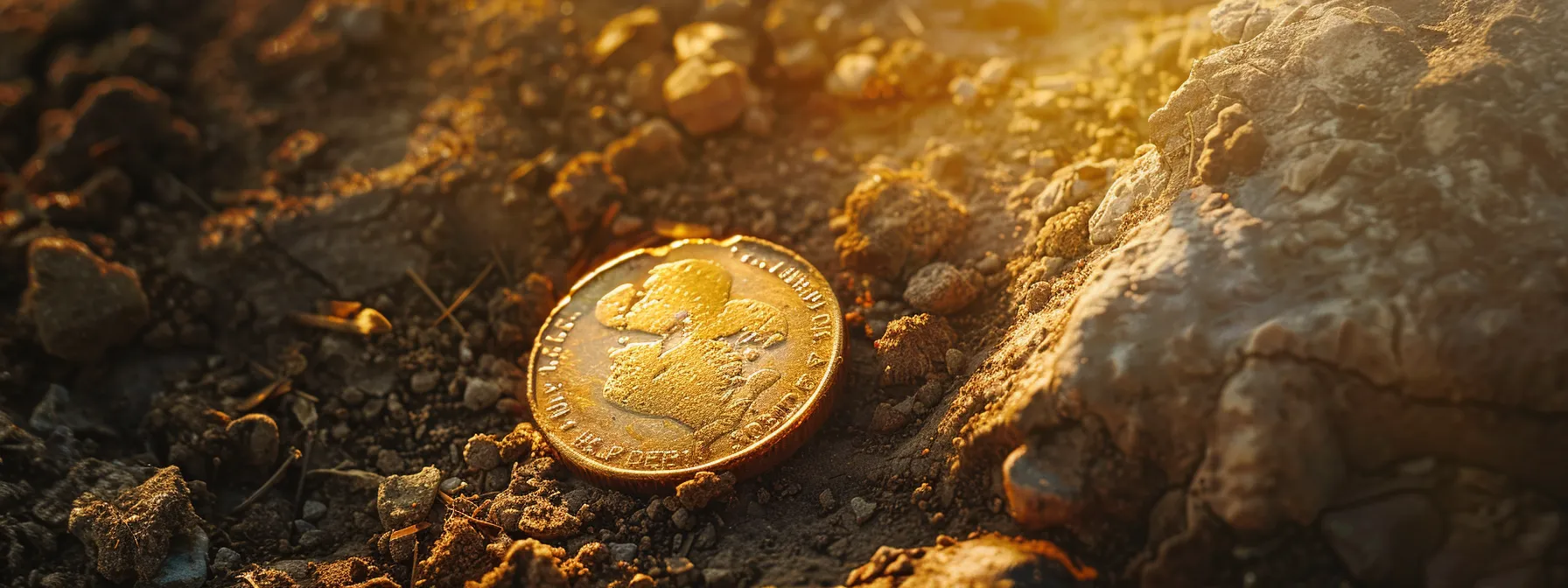

Are you struggling to find that elusive gold nugget while metal detecting? Ground balance is a crucial setting that can significantly impact your success. In this article, we’ll explore the different types of ground balance methods, steps to optimize your machine‘s settings, and common challenges that metal detectorists face. By refining your ground balance, you’ll enhance your hunting performance, making it easier to detect targets even in tricky soil conditions. Get ready to boost your metal detecting skills and uncover more treasures!
Understanding Ground Balance in Metal Detecting

Ground balance is crucial for effective metal detecting, as it helps filter out unwanted signals from the soil. By understanding soil mineralization’s impact, I can fine-tune my detector settings, enhancing its discrimination capabilities. This not only improves accuracy but also increases the depth of my finds, be it a bottle cap or silver. Now, let’s dive into how to master this essential skill best metal detectors.
Defining Ground Balance and Its Importance
Ground balance is a key feature in metal detecting that allows me to fine-tune my best metal detectors for the specific soil conditions I’m working with. Whether I’m prospecting in sandy areas or rocky soils, adjusting my detector‘s ground balance helps minimize interference from mineralized soil, ensuring that the signals I pick up are from actual treasures rather than false signals caused by the ground’s electronics. This adjustment is crucial; it not only increases my chances of unearthing valuable finds but also enhances the overall accuracy of my treasure hunting adventures.
| Soil Type | Electronics Response | Recommended Ground Balance Setting |
|---|---|---|
| Sandy | Minimal interference | Lower ground balance |
| Clay | High mineralization | Higher ground balance |
| Rocky | Chaotic signals | Adjust as needed |
Effects of Soil Mineralization on Detection
Soil mineralization plays a significant role in how my metal detector, like the Manticore, responds to different targets. For instance, areas with high iron content might produce a lot of unwanted signals, often masking the ferrous targets I’m hoping to find, such as coins or relics. On the flip side, when I’m out gold prospecting, optimizing my ground balance helps my detector to react more accurately to gold signals while reducing interference from magnetic minerals, ensuring I don’t miss out on precious finds.
How Ground Balance Improves Accuracy and Depth
When I optimize the ground balance on my best metal detectors, I significantly improve both accuracy and depth. By carefully adjusting the settings to account for mineral content and electromagnetic interference (EMI), I can filter out noise from the ground, like chatter from ferrite minerals. This fine-tuning allows my detector to focus on true metal signals, leading to more reliable readings and deeper detection of valuable items, whether I’m on the hunt for coins or historic relics Tips and Tricks:
- Adjust ground balance to match soil mineralization.
- Account for EMI to reduce false signals.
- Focus on true metal responses for higher accuracy.
- Enhance depth detection for better finds.
Now that we grasp the importance of ground balance, it’s time to explore the different methods used to achieve it. Each technique offers unique benefits, and understanding them can improve your treasure hunting experience.
Types of Ground Balance Methods

Understanding the different ground balance methods can significantly enhance my metal detecting experience. In this section, I’ll explain manual ground balance, how automatic ground balance features simplify adjustments, and when to use tracking ground balance. I’ll also guide you on selecting the best method for your needs, ensuring you get the most from your searches in the Best Metal Detecting Locations. With insights drawn from my experiences and recommendations from Loot Detective, I aim to help you streamline your treasure hunting efforts.
Manual Ground Balance Explained
When using manual ground balance, I take control of how my metal detector reacts to the soil I’m searching. This method requires me to adjust the settings while actively listening for changes in signal response. For example, when I’m out on the beach, applying Beach Metal Detecting Tips like setting my ground balance to account for wet sand helps to minimize interference. By doing this, I can significantly improve my chances of finding valuable treasures that others might miss. I learned these techniques from resources like the Ottawa Track and Trail Club and recommendations from brands such as Minelab USA and Kellyco Detectors, enriching my experience and results in every hunt.
Automatic Ground Balance Features
Automatic ground balance features are a lifesaver when I’m out in the field, as they adjust my metal detector to suit various soil conditions without requiring much input from me. This technology is particularly useful in areas with shifting soil types or during fluctuating weather conditions, allowing me to focus more on my search rather than fiddling with settings. For example, when I’m detecting in a location with mixed soil types, my detector continually compensates for changes, ensuring I capture true metal signals while filtering out false alerts.
Tracking Ground Balance and When to Use It
Tracking ground balance is a useful feature that adjusts my metal detector in real-time as I move through varying soil types. For instance, when treasure hunting in areas where the ground changes from sandy to clay or rocky, this feature continuously fine-tunes the detector to ensure I receive accurate signals. By utilizing tracking ground balance, I can concentrate on detecting valuable items without being distracted by fluctuating signals, helping me uncover more treasures that others may overlook.
Selecting the Appropriate Method for Your Needs
Selecting the right ground balance method for your metal detecting adventures is essential for success. If I’m searching in a stable location with uniform soil, I often find manual ground balance gives me the control I need to fine-tune the detector. However, in environments with rapidly changing soil conditions, I rely on automatic or tracking ground balance features to keep my focus on detecting targets, ensuring I don’t miss hidden treasures because of fluctuating soil types:
| Ground Balance Method | Ideal Situations | Advantages |
|---|---|---|
| Manual Ground Balance | Stable, uniform soil | Full control and precision |
| Automatic Ground Balance | Mixed soil types | Easy adjustments, saves time |
| Tracking Ground Balance | Variable soil conditions | Continuous adjustments for accurate signals |
Understanding the types of ground balance methods is just the beginning. Next, let’s dive into the steps that will help you fine-tune your settings for optimal results in the field.
Steps to Optimize Ground Balance Settings

Steps to Optimize Ground Balance Settings
To enhance my metal detecting performance, it’s essential to optimize the ground balance settings effectively. I start by evaluating the mineralization of the area, followed by preparing my detector for calibration. Adjusting manual ground balance settings allows for precision. If my detector has automatic or tracking options, I utilize those to further refine my setup. Finally, I always test and fine-tune in the field to ensure I’m ready for any treasure that may lie beneath the surface.
Evaluating the Mineralization of the Area
When I arrive at a new detecting site, the first step I take is evaluating the mineralization of the area. This involves examining the soil, as certain locations may contain high iron or mineral content that can interfere with my metal detector‘s performance. By identifying these factors early on, I can make necessary adjustments to the ground balance settings, which ultimately enhances my chances of finding valuable items like coins or relics buried beneath the surface.
Preparing Your Detector for Calibration
Before I dive into calibrating my metal detector’s ground balance, I make sure it’s in good working order. I perform a thorough inspection, checking the battery levels and ensuring all connections are secure. This preparation sets the stage for accurate calibration, allowing me to effectively adjust the settings according to the soil conditions I’ll encounter, maximizing my detection performance and treasure-finding potential.
Adjusting Manual Ground Balance Settings
When adjusting manual ground balance settings, I start by tuning my metal detector to eliminate unwanted signals from the soil. I slowly sweep my detector over the ground while listening for changes in signal response. If I notice a significant tone change, I tweak the ground balance control until the detector becomes silent over the mineralized areas, allowing me to focus on the targets I’m truly seeking:
- Begin by assessing the soil type at your location.
- Gradually adjust the ground balance control while sweeping the detector.
- Listen for changes in signal response and fine-tune accordingly.
- Test the settings on known targets to ensure accuracy.
Utilizing Automatic and Tracking Options Effectively
Utilizing automatic and tracking options on my metal detector can greatly enhance my efficiency, especially in varied soil conditions. When I activate automatic ground balance, my detector continuously adjusts to the soil, which saves me time and allows me to focus entirely on uncovering treasures. Tracking ground balance is essential for sites where the soil frequently shifts; it automatically fine-tunes my settings as I move, ensuring I’m always picking up valid signals without distraction:
- Engage automatic settings for consistent adjustments.
- Utilize tracking features in shifting soil conditions.
- Focus on detecting without frequent manual adjustments.
Testing and Fine-Tuning in the Field
After I’ve adjusted my metal detector‘s ground balance settings, the real test comes when I’m out in the field. I recommend finding a known area with mixed soil types or targets to confirm my settings are accurate. As I scan the ground, I listen carefully for any unwanted signals or inconsistencies; if something seems off, I make quick adjustments. Testing frequently allows me to ensure my detector remains responsive to true metal signals while filtering out noise from the soil:
| Action | Details | Expected Outcome |
|---|---|---|
| Scan with Known Targets | Use a specific target like a coin or relic. | Confirms the detector responds correctly. |
| Listen for Signals | Pay attention to the sound while sweeping. | Identifies if adjustments are needed. |
| Make Quick Adjustments | Fine-tune settings based on feedback. | Improves signal accuracy and minimizes noise. |
Even with the right settings, ground balance can still cause trouble. Let’s tackle the common hurdles that can trip us up and how to overcome them.
Overcoming Common Ground Balance Challenges

To truly enhance my metal detecting performance, I need to address common ground balance challenges. I’ll cover how to spot signs of improper ground balance, adjust for highly mineralized soils, and deal with disruptive elements like hot rocks and black sand. Additionally, I’ll share practical tips for navigating saltwater and wet sand environments, ensuring I remain effective no matter where I hunt.
Identifying Signs of Improper Ground Balance
As I dig into my metal detecting sessions, I quickly learned to recognize signs of improper ground balance, which can hinder my success. If my detector is emitting erratic sounds or producing a constant hum when scanning the ground, those are clear indicators that the settings may not be properly adjusted for the soil conditions. Additionally, finding a lot of false signals, especially over areas that I know to be clean of trash, often hints at mineralization issues needing my attention. Addressing these signs promptly not only improves my accuracy but also ensures a more enjoyable hunt overall.
Adjusting for Highly Mineralized Soils
When I encounter highly mineralized soils, I need to make specific adjustments to my metal detector‘s settings to minimize interference. This involves setting a higher ground balance to counter the effects of magnetic minerals that can mask valuable signals. I’ve found that taking the time to fine-tune these settings not only improves my chances of finding target items but also helps ensure a more enjoyable detecting experience.
| Soil Condition | Recommended Ground Balance Setting | Effects of Not Adjusting |
|---|---|---|
| Highly Mineralized | Higher ground balance | False signals and missed targets |
| Moderately Mineralized | Moderate ground balance | Reduced depth detection |
| Low Mineralization | Lower ground balance | Overdetection of small iron objects |
Dealing With Hot Rocks and Black Sand
Dealing with hot rocks and black sand has been a significant adjustment in my metal detecting journey. These naturally occurring materials can create erratic signals that confuse the detector and detract from my search. I’ve learned that adjusting the ground balance to a higher setting can help filter out these distractions, allowing me to focus on genuine targets while minimizing false signals. When I’m detecting in sandy beach environments, I make it a point to routinely fine-tune my settings to adapt to these conditions, ensuring my metal detector performs at its best and that I don’t miss valuable finds lurking beneath the surface.
Tips for Saltwater and Wet Sand Environments
When hunting in saltwater or wet sand environments, I find that adjusting the ground balance of my metal detector is essential to achieving optimal performance. Saltwater can introduce significant mineralization, which can lead to false signals and erratic detector responses. To combat this, I set my ground balance to account for the unique conditions of wet sand; doing so ensures my detector remains sensitive to actual treasure signals rather than being overwhelmed by the noisy signals created by minerals in the sand:
| Environment | Recommended Ground Balance Setting | Expected Outcome |
|---|---|---|
| Saltwater | Higher ground balance | Minimized false signals |
| Wet Sand | Moderate ground balance | Improved target detection |
Even after clearing the common balance hurdles, there’s more to master. Let’s sharpen our skills with advanced techniques that will take your ground balance to the next level.
Advanced Techniques for Ground Balance Optimization

Using Ground Balance Offset can significantly enhance my detection results, allowing for more accurate readings tailored to specific environments. Integrating ground balance with other settings like sensitivity and discrimination creates a more cohesive detecting experience. Customizing my settings for specific targets ensures I maximize my finds, while maintaining optimal performance across different terrains helps me adapt to changing conditions efficiently.
Using Ground Balance Offset for Better Results
Using a ground balance offset can significantly enhance my metal detecting results by allowing me to customize my settings based on the specific conditions I’m facing. For instance, when I know I’m in an area with varying mineral content, applying a negative ground balance offset helps filter out the unwanted signals, enabling my detector to focus on the metal targets that really matter. This tactic not only sharpens the detector‘s responsiveness but also leads to clearer signals, improving my chances of uncovering valuable items that others might miss due to noise interference.
Integrating Ground Balance With Other Settings
Integrating ground balance with other detector settings is essential for optimizing my metal detecting performance. By adjusting sensitivity alongside ground balance, I can enhance the depth and accuracy of my finds. For instance, in highly mineralized soil, lowering my sensitivity while fine-tuning my ground balance helps to reduce noise, allowing genuine targets to shine through without disturbance:
- Balance ground settings with sensitivity for better depth.
- Adjust discrimination settings to focus on specific targets.
- Consider recovery speed to improve responsiveness on fast sweeps.
Customizing Settings for Specific Targets
Customizing settings for specific targets is an important technique I rely on to maximize my metal detecting efforts. For example, when I’m specifically looking for gold rings, I adjust my ground balance and discrimination settings to focus on the right frequency that enhances sensitivity to those smaller, precious items. Fine-tuning these settings not only helps me detect valuable finds but also minimizes false signals from less relevant objects:
- Lower sensitivity for iron targets while increasing it for gold.
- Adjust ground balance to accommodate specific soil conditions.
- Switch between all-metal mode and discrimination mode based on the target type.
Maintaining Optimal Performance Across Different Terrains
Maintaining optimal performance across different terrains is essential for successful metal detecting. I find that adjusting my ground balance settings according to the environment can significantly affect my results. For example, when I transition from rocky soil to a sandy beach, I make quick adjustments to my detector to ensure it remains sensitive to valuable targets while filtering out the noise that could lead me astray. This attention to detail not only enhances my detection capabilities but also keeps my search efficient and focused.
With the ground balance set, you’re ready to dig deeper. Let’s look at how to boost your detecting skills to uncover even more hidden treasures.
Maximizing Metal Detecting Performance Through Ground Balance

To maximize my metal detecting performance, I focus on enhancing sensitivity and signal clarity while reducing false signals and noise. In the following sections, I’ll share case studies of effective ground balancing techniques I’ve employed and emphasize the importance of continual learning and adaptation. These insights are essential for treasure hunters looking to improve their results and uncover valuable finds.
Enhancing Sensitivity and Signal Clarity
Enhancing sensitivity and signal clarity is vital for my success in metal detecting. When I fine-tune my detector settings to maximize sensitivity, I can better distinguish between valuable targets and unwanted signals, especially in challenging environments like highly mineralized soils. For example, during a recent hunt at an old battle site, I adjusted my ground balance to minimize noise, which not only improved my ability to hear faint signals but also led to a fantastic find of a historic button that others might have missed due to poor signal clarity.
Reducing False Signals and Noise
Reducing false signals and noise is a key part of optimizing ground balance in metal detecting. When I adjust my metal detector to account for mineralization and electromagnetic interference, I often notice a significant decrease in unwanted alerts. For example, last summer, while searching an old park, I experimented with settings and found that increasing the ground balance helped filter out excess chatter from iron-rich soil, allowing me to focus on clearer signals and increasing my chances of finding valuable items.
| Technique | Description | Expected Result |
|---|---|---|
| Increase Ground Balance | Adjust settings to counteract harsh mineralization. | Minimized background noise for clearer signals. |
| Adjust Sensitivity | Lower sensitivity in highly noisy areas. | Reduced false alerts, focus on actual targets. |
| Real-time Testing | Continuously assess settings during a hunt. | Immediate improvements in signal clarity and reliability. |
Case Studies of Effective Ground Balancing
One effective case study I experienced was when I was hunting in a highly mineralized area known for its rich history. Before diving in, I adjusted my metal detector‘s ground balance to a higher setting to combat the interference from the soil. As a result, I noticed a significant decrease in false signals, allowing me to focus on authentic treasures. Following this adjustment, I uncovered a rare coin that others had missed due to their detectors picking up noise rather than the real signals. This experience underscored the importance of optimizing ground balance for improving detection success.
Continual Learning and Adaptation for Success
Continual learning and adaptation are essential for maximizing my metal detecting performance, especially regarding ground balance. As I encounter different environments and soil types, I make it a priority to adjust my techniques and settings accordingly. For example, attending local metal detecting workshops and engaging with experienced hunters has provided me with valuable insights that I apply during my hunts. By staying open to new information and experimenting with my equipment, I can enhance my chances of unearthing hidden treasures while navigating the challenges that each unique landscape presents.
Conclusion
Optimizing ground balance is essential for enhancing metal detecting performance, as it allows the detector to filter out unwanted signals from mineralized soil. By fine-tuning settings based on soil conditions, I can improve accuracy and depth, increasing the chances of valuable finds. Utilizing methods like manual, automatic, and tracking ground balance ensures adaptability to various environments, making each hunt more productive. Ultimately, mastering ground balance not only boosts my treasure hunting success but also enriches the overall experience in the field.


